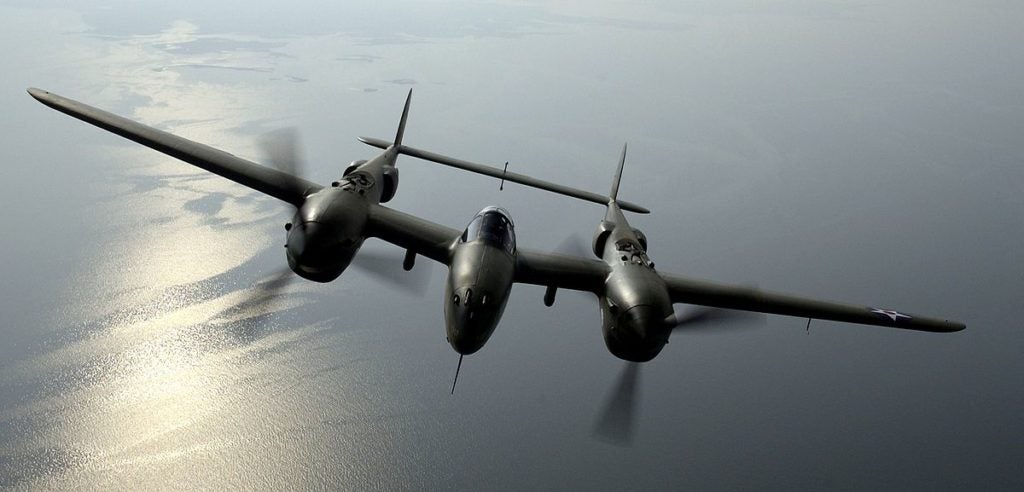

Among the fighters that allowed America to win World War II, the P-38 Lightning was uniquely successful and was dubbed the “fork-tailed Devil” by the Germans even though its greatest successes came in the Pacific, Mediterranean, and North African theaters.
Army Air Corps leaders first solicited for what would become the P-38 in 1937 with the specification X-608, a request for a new pursuit aircraft that could fly 360 mph at 20,000 feet, reach 20,000 feet in six minutes, and run at full power at that altitude for at least an hour. They also wanted a long combat radius and plenty of firepower.

Lockheed, a newcomer to the military market, submitted the XP-38, a radical departure from conventional aircraft design that featured three pods and two tails. The outer pods lined up with the tails and each carried an Allison V-1710 engine with 1,000 hp.
While the XP-38 was a radical design, the Army adopted it anyway because they needed its power and speed to compete with new German and British designs. And it packed a lot of punch with four .50-cal. machine guns and a single 20 mm cannon, all crammed into the nose.

The plane went through continued testing and design refinements before reaching Army pilots in 1940. Upon its debut, it was capable of reaching an altitude of 3,300 feet in one minute and could hit 400 mph with a range of 1,150 miles.
But production was slow and the Army had only 69 P-38s, so Lockheed was forced to subcontract parts to get the plane into combat for the U.S. But the P-38 arrived on the front lines with a vengeance. In early 1942, its pilots became the first Americans to down a Luftwaffe plane and P-38s carried seven of the top fighter aces of the Pacific theater.
The Lightning’s finest hour probably came on April 18, 1943. Naval Intelligence had learned that Japanese Adm. Isoroku Yamamoto, the commander and architect of the Pearl Harbor attacks, would be inspecting troops in the Pacific on that date.

The military rushed together a plan to attack the admiral. The scheme called for fighters to fly approximately 600 miles out and 400 miles back with enough fuel available in the middle for fierce fighting. The only Pacific fighter capable of the feat in 1943 was the fork-tailed devil equipped with drop tanks.
A kill team of four P-38s flew with 12 others to an intercept point, dropped their tanks, and attacked the two bombers and six fighters of Yamamoto’s flight and escort. Two Americans had to peal off when their drop tanks failed to disconnect, but the other 14 successfully downed both bombers and the Zeros bugged out. One P-38 was lost in the battle and Yamamoto was killed along with his deputy.
America’s top-scoring fighter ace of all time, Maj. Richard Bong, achieved all of his 40 aerial victories in P-38s and the number two ace, Maj. Thomas B. McGuire, Jr., achieved most of his 38 kills in the P-38.

All of this is not to say that the fork-tailed devil was perfect. It suffered a number of drawbacks including a tendency to become unstable at speeds approaching Mach 1 and to become unresponsive to controls during high-speed dives.
In Europe, the plane that dominated over the Pacific became a major liability for pilots because it wasn’t designed to withstand the extreme cold of Europe’s winter air at 20,000 feet and higher, especially in the particularly bitter 1943-1944 winter.
Pilots suffered hypothermia and frostbite in the barely heated cockpit and the engines were prone to failures as their intakes over-cooled incoming air.
The commander of the 20th Flight Group, Col. Harold J. Rau, was ordered to provide a written report as to why the P-38 wasn’t more successful in Europe. He asked the recipient to imagine a fresh-out-of-flight-school with less than 30 flight hours who was suddenly attacked by Luftwaffe fighters.
He must turn, he must increase power and get rid of those external tanks and get on his main. So, he reaches down and turns two stiff, difficult gas switches to main, turns on his drop tank switches, presses his release button, puts the mixture to auto rich, increases his RPM, increases his manifold pressure, turns on his gun heater switch, turns on his combat switch and he is ready to fight.
And the process was unforgiving of errors. Reversing the order of the engine steps or skipping a step could cause the engine to explode or throw a rod, either of which would rob the pilot of vital power during a dogfight. And all of this has to be done while German rounds are already ripping past or through the plane.
Luckily, the debut of the P-51 gave a viable alternative to the P-38. It didn’t suffer from the cold-weather problems of the P-38 and had comparable or better speed, range, and maneuverability at most altitudes while being easier for rookies to fly. It’s only major shortcoming against the fork-tailed devil was that it had only one engine and it was more susceptible to damage than either of the Lightning’s two.
